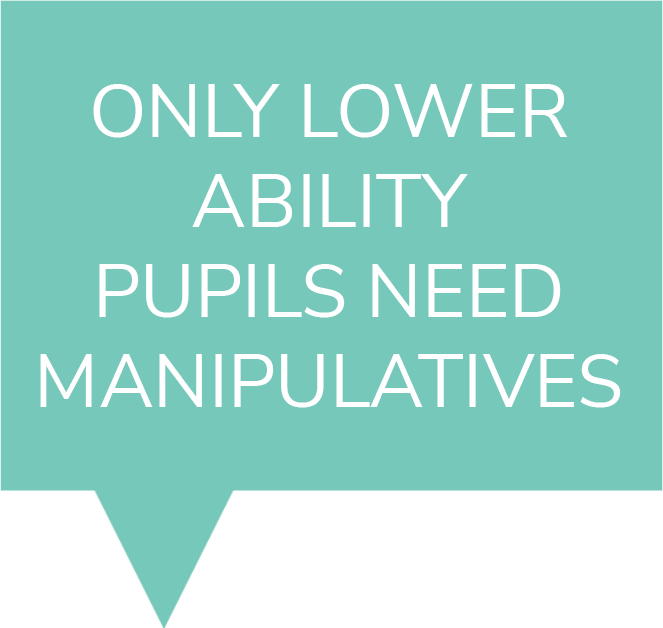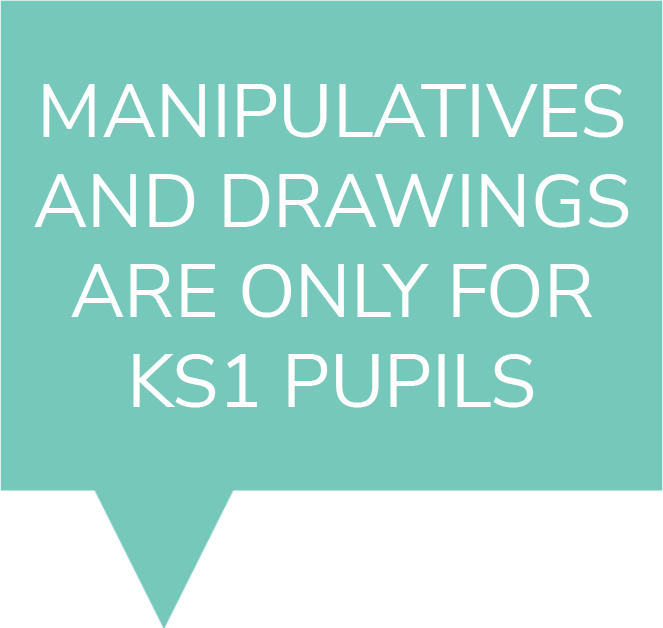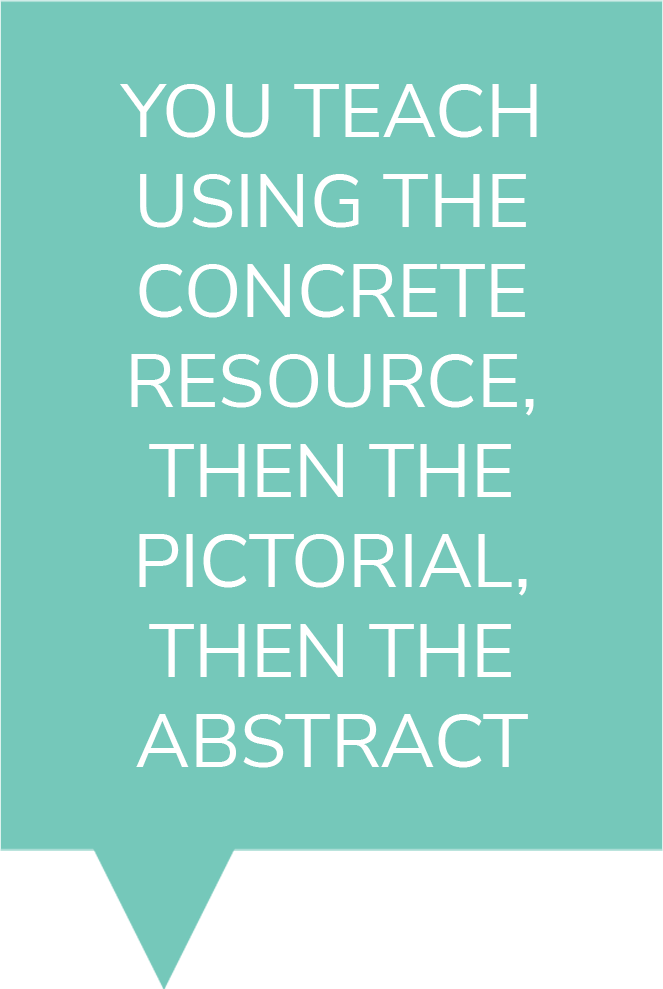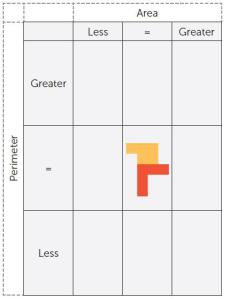One of the most fundamental learning theories to be implemented within any mastery classroom is the ‘CPA’ (Concrete, Pictorial, and Abstract) approach. It was first proposed by Jerome Bruner in 1966 as a means of scaffolding learning. The psychologist believes that the abstract nature of learning (and this is especially true in mathematics) is a “mystery” to many children. It, therefore, needs to be scaffolded by the use of effective representations. He saw that, when pupils used the CPA approach, they were able to build on each stage towards a fuller understanding of the concepts being learnt and, as such, the information and knowledge were internalised to a greater degree. This allowed the teacher to build upon this secure learning. Bruner, and others, demonstrated that each stage of the approach acts as a scaffold for subsequent and connected learning.
Manipulatives in the classroom
This stage should always be used during the learning of new concepts or when building further onto learnt concepts for every child in the classroom. It can also be used to help pupils demonstrate their understanding of concepts or to see the learning in a different way. It involves the physical manipulation of objects to explore structure, find commonalities and rehearse the mathematics. There are many manipulatives to choose from and schools are increasingly aware of the importance of this stage and investing accordingly. There are many benefits in this stage. When pupils are acting on the mathematics with the manipulatives they are also more likely to form the language to communicate concepts and ideas. This allows teachers to gain a greater understanding of where misconceptions lie and the depth of understanding a child exhibits. It, also, allows pupils to develop their ability to communicate mathematically and to reason. In fact, it is almost impossible for reasoning not to happen in a classroom where manipulatives are used regularly.
Using visual representations in primary maths
This stage involves the use of images to represent the concrete situation enacted in the first stage. It can be pupils’ drawings of the resources they are acting on or a representation such as the bar model, number line or a graph. This stage acts as a ‘bridge’ to support pupils to make links between the concrete and the abstract and develops their ability to communicate and to represent their mathematics. This stage is commonly overlooked by schools where representation and pupils’ own recording is not valued highly enough. To miss this stage out assumes pupils have made the cognitive link between the concrete resource and the abstract notation.
Symbols and mathematical reasoning
This is the use of words and symbols to communicate mathematically. It is difficult for pupils to get to this stage without the other two stages working alongside. This is because words and symbols are abstractions. They do not necessarily represent a direct connection to the information. For example, a number is a symbol used to describe how many of something there are, but the symbol of a number, in itself, has little meaning. Why should a ‘5’ represent five any more than the digit ‘2’ stand for five? The other stages support pupils’ understanding of this stage.
The ultimate aim of the CPA approach is to help pupils develop confidence and security when working with the abstract representations. As one of our leading teachers commented, “It is important for teachers to explain how symbols can provide a shorter and efficient way to represent numerical operations.” Tia Robinson, Yewtree Primary School
Common myths about CPA in maths

Only lower ability pupils needs manipulatives
In the CPA approach all pupils should have access to manipulatives when any new learning is explored or when the teacher is building on a previous concept. The use of manipulatives can challenge even those pupils who appear to have grasped the learning. It is certainly true that some pupils may need more access to manipulatives and for longer. But the use of manipulatives supports pupils’ mathematical reasoning and some pupils who appear to grasp concepts rapidly, may not have as fully developed an understanding as we might expect. The use of manipulatives helps teachers to mitigate this risk. See the example below where a group of year two pupils, who had been identified as having sufficient grasp of the subject, were challenged even more deeply through the use of manipulatives.

Manipulatives and drawings are only for KS1 maths
All age ranges benefit from the use of manipulatives to support their conceptual development. It is equally as important in KS2 as in KS1. Consider the case study below and how the activity using pentominoes might support an increased understanding about the relationship between area and perimeter.

You teach using the concrete resource, then the pictorial, then the abstract
All stages should be taught simultaneously whenever a new concept is introduced and when the teacher wishes to build further on the concept. See how, in the example below, pupils are using concrete resources, pictorial and abstract recording – all within the same activity. This ensures that the pupils are able to make good links between each stage. At various points in a sequence of learning, the teacher may reintroduce the concrete resource to develop reasoning and the ability to see multiple representations of a concept.
CPA case study: Andrew’s Lane Primary School, Cheshunt
Child ‘H’ has always struggled with number concepts; they were the kind of ‘mystery’ to her that Bruner contemplated in his research. The school is currently reviewing the way it teaches calculation and received some training, including the use of the CPA approach from an HfL teaching and learning adviser. After the training, the year four teacher, Sam Babb, used the approach extensively with all of her pupils. She noticed the progress being made had been underpinned by the use of the manipulatives (Base- 10 or Dienes equipment). Child ‘H’, in particular, made significant progress in her understanding of the idea of exchange when adding and subtracting towards the formal written method. By the end of the sequence of learning, the physical act of exchanging ones for tens and tens for hundreds had allowed her to develop a physical memory of the concept. From there, she went on to choose increasingly challenging work and was soon engaging in the most challenging learning set in the classroom confidently.
KS2 CPA Case Study (with thanks to Professor John Mason; Open University for this idea)

Pupils are asked to place two pentominoes together and to find their area and perimeter. Then, they are asked compare against the shape in the middle of the grid and to record the new shape in the correct cell. They must find at least two arrangements that would fit the criteria of each cell.
Has their new shape got a larger or smaller area than the shape in the middle? What about its perimeter?
Which cells cannot be filled with two pentominoes? Why? What happens if we can use upto three pentominoes (including combinations using the same pentomino shape)? Can all the cells be filled then? How many different shapes can be made that have an equal area and perimeter to the shape in the centre? Can we use squared paper to draw other shapes that meet the criteria for each cell?
What do pupils notice about shapes that have a greater area but smaller perimeter than the shape in the middle? When could we say shapes have a greater perimeter but less area? What generalisations can we draw about the relationship between area and perimeter? The teacher should then allow time for pupils to further ‘test’ these conjectures.
Finally… As we have stated, the ‘CPA’ approach to the teaching and learning of mathematics is fundamental to the mastery curriculum. It underpins every sequence of learning planned for and taught. But it should be noted that even if schools are not yet in a position to be engaging in teaching for mastery, the approach has enormous benefits to excellence in the teaching and learning of mathematics. Ofsted recognise the approach, and the lead inspector for mathematics, Jane Jones, has specifically referenced the use of manipulatives and the development of reasoning as crucial to good mathematical development in our pupils. It is the ability to transfer understanding between resource and action, representation, symbol, language, real life experience and application that truly denotes mastery of learning. The ‘CPA’ approach captures and models this with pupils.
Further reading:
Explore More on CPA (Concrete, Pictorial, Abstract) Approach
What do we mean by ‘pictorial’ in the CPA approach?
A focused look at the pictorial stage, with classroom examples and key representations.
The Concrete, Pictorial Abstract (CPA) approach for teaching and mastering times tables


